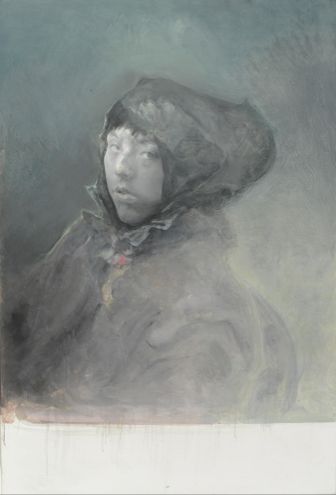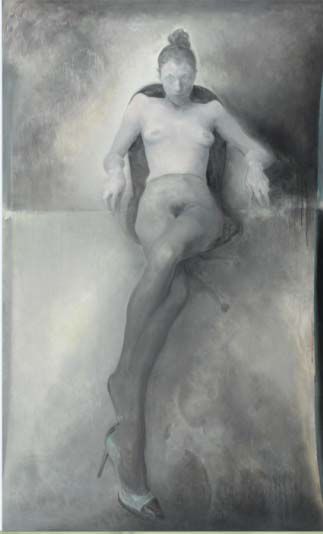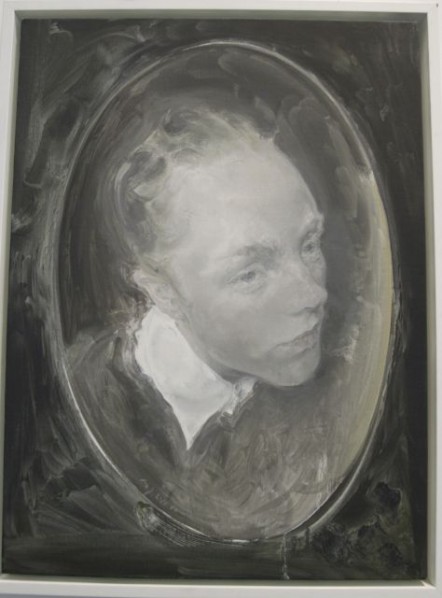
Mao Yan, "Hua", 2012; oil on canvas, 1100x750mm
Pace Beijing is presenting a solo exhibition by one of China’s most influential portrait artists, Mao Yan. This exhibition is also the first exhibition of Mao Yan since his representation by Pace Beijing.
Mao Yan is well known by his portrait art. His artworks reveal the momentary glory of peace and attract audience into his artworks through the very straight expressions without any metaphor. Mao Yan insists the spiritual dominances in his paintings and depicts the same object though years, in which he has controlled the arbitrary sorrows and the flow of emotions and showed the tension of strokes in a show but calming way. Through the unique image he created and the motion he captured, Mao Yan expresses the light atmosphere that is attracted by a certain moment in memory and weakens the characteristics of a certain figure. Therefore he focuses solely on the language of art and shows the theme that is both magnificent and decadent. We could say that the art of Mao Yan has represented the whole face of an era that is remote but real.

Mao Yan, "Faerie on the Chair", 2013; oil on canvas, 3300X2000mm
In Mao Yan’s portrait, the feature of time on a figure’s appearance has been removed, and only the common spirit of human beings is still maintained. The gray tone shows his experience and observation over the long and dim modern history. Mao Yan chooses an individual as his standpoint and his personal opinion as the foundation, and he dimes any relations with his personal symbol and gets rif of subjective emotional judgment to avoid any symbolic or metaphoric meanings. Mao Yan depicts the same figure over years. Such behavior is bases on the opposite of his own spiritual power. Yet in his nob-sketching creation process, he not only removes the steadiness and flatness of photographs, but also revert the reality of scene and the vividness of the material, which expresses his personal pursuit to the figure. Mao Yan keeps his pursuit to spirit and the vague memory, embeds his personal feelings into the tone of era, and by making use of his talent and feelings, he presents the dim light of human soul and shows a unique figure that is calm and peaceful. Other than new works from the series of Thomas, which the artists has been continuing since late 1990s, the first-time large scale painting of female body will be another focus of this solo exhibition. Faerie on the Chair and the Plump Nude show the rare female figure in portrait paintings. In these two paintings, Mao Yan depicts and compares the flirting slim model sin the chair and the plump lady who curls up at the exact same place. In addition, Mao Yan will present artworks about animal heads which are unorthodox. For example. Fish Head for Goya is a tribute to the Spanish romantic master Goya, who has a huge influence on Mao Yan. We can look forward to seeing Mao Yan’s technique on controlling the painting’s atmosphere and the rare talent the possesses again in this solo exhibition at Pace Beijing.

Mao Yan, "Posie Musgran No.2", 2010; oil on canvas, 537x726mm
About Mao Yan
Mao Yan (b. 1968, Hunan Province, China) is considered as one of China’s outstanding contemporary portrait artists. Under his father’s influence, Mao Yan began studying painting at an early age. By the time he was a teenager he has already mastered advanced techniques, and his talent was recognized even before he was admitted to the Central Academy of Fine Arts. In 1991, after graduating from the Oil Painting Department at the Central Academy of Fine Arts in Beijing, Mao Yan began to delve into portraiture. In his article Exploration in Realism, renowned art critic Li Xianting stated Mao Yan’s works depict the “portraits of a generation whose emotions are gradually disappearing”. Gray tones, delicate molding, and mottled brushstrokes allow Mao Yan’s works to retain all detail and vitality, whether displayed under natural or gallery lighting.
Around 1995, Mao Yan’s paintings began to move from the standards of conventional portraiture towards smaller, quieter pieces. His impudent, flaming colors and warm browns gradually became sober-infiltrated by gray, ashen tones that concealed the paintings foundations. At the end of the 1990s, Mao Yan began using Thomas, an exchange student from Luxembourg, as model, spending ten years on one portrait. The series continues to this day, but the artist also continues to pursue a more dynamic path. He gains a sense of inherent classicism and security from using familiar symbols, yet only with unceasing concentration and focus can a painter’s style be used as a tool to give form to abstract reflection, and that still requiring a callous inhibition of ever-present, hovering uncertainty. In his recent works, Mao Yan focuses on the experiment o depicting female portrait and sill life, rendering his homage to Romanticism masters such Goya and Delacroix. The meaning in Mao Yan’s endeavors does not lie in the idea of “portraits”. Rather, his works are “paintings of portraits”—borrowing the contour and movement of a character in order to substantialize outline, color and composition. It is within the framework of realism that such deep, subtle inquiries into human mentality can be made.
In the end, a simple paintings is no more than another way of viewing the world; the significance of Mao Yan’s works has been displayed in large-scale exhibitions both at home and abroad, including Mao Yan at Pace Beijing(2013), 30 Years of Chinese Contemporary Art at the Mingsheng Art Museum, Shanghai(2010), Longing for More, Mao Yan’s Solo Exhibition at the Shanghai Art Museum( 2009), China, Construction and Deconstruction at the National Gallery of St. Paul, Brazil( 2008), Today’s China at Beivue Museum in Brussels(2008), and Paris: Beijing at Espace Pierre Cardin, Paris(2008).
About the exhibition
Duration: May 11, 2013 - Jun 22, 2013
Venue: Pace Beijing
Address: 798 Art District, No. 2 Jiuxianqiao Road, Chaoyang District, Beijing 100015
Tel: +86 01 5978 9781
Fax: +86 10 5978 9781-818
Tues - Sat 10 to 6
Courtesy of the artist and Pace Beijing.




























